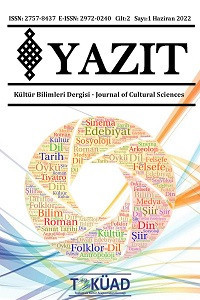Geleneksel Kültürün Yapılaşmış Çevreye Etkisi: Çerkes Kültürü Örneği
Somut ve somut olmayan tüm kültürel değerler, toplumların kültürlerinin sürdürülebilirliği açısından önemlidir. Küreselleşmenin etkisi ile somut olmayan kültürel miras değişime ve dönüşüme uğrarken somut kültürel miras zaman içinde somut olmayan kültürel mirasa göre sürdürülebilirliğini daha iyi sağlayabilmektedir. Çalışmanın odak noktası olarak ele alınan geleneksel kültür kavramı, somut olmayan kültürel miras kapsamında, modern dünyanın tüm kültürel yönlerinin tarihsel temelini oluşturmaktadır. Son yıllarda küreselleşme ile birlikte kültürel çeşitlilikten tek tip kültürlülüğe doğru giden bir gelişim başlamıştır. Bu kapsamda ele alınan Çerkes kültürünün tarihsel süreç içerisindeki değişimi ve bunun yapısal çevresine yansıması konunun anlaşılmasına yardımcı olmuştur. Çalışmanın metodolojik temelini tarihsellik ve nesnellik ilkeleri oluşturmaktadır. Kültürel-mekânsal etkileşim yöntemi ile geleneksel Çerkes kültürünün tarihsel süreç içerisinde yapılaşmış çevresine etkisi açıklanmaktadır. Kültüre ait unsurların değişen zaman ve dış etkilerle birlikte yapısal çevre üzerindeki etkisi analiz edilmiştir. Gelenekleri açısından kadim bir toplum olan Çerkeslerin kültürü tarihsel süreç içerisinde çok değişmiş ve bu değişim yaşam alanlarına yansımıştır. Değişimin etkilerini azaltmak için, topluma ve çevreye sıkıca bağlı olan insanlar yaşayacakları alanı oluştururken geleneksel verilerden yararlanmalıdır. Böylece toplumun maddi ve manevi kültürünü içeren kültürel miras nesilden nesle aktarılabilir ve ait olduğu yerde hayatımızda hep bizimle kalır.
Anahtar Kelimeler:
geleneksel kültür, toplumsal yaşam, yaşam alanı, yapılaşma, Çerkes kültürü
The Effect of Traditional Culture on the Artificial Environment: The Case of Circassian Culture
All tangible and intangible cultural values are important for the sustainability of the cultures and histories of the settlements of societies. With the effect of globalization, while tangible cultural heritage ensures its sustainability over time, intangible cultural heritage undergoes change and transformation. The concept of “traditional culture”, which is considered as the focus of the study, constitutes the historical basis of all cultural aspects of the modern world within the scope of intangible cultural heritage. In recent years, with globalization, a development from multiculturalism to monoculturalism has started. In this context, the change of Circassian culture in the historical process and its reflection on its artificial environment helped to understand the subject. The methodological basis of the study is historicism and the principles of objectivity. With the cultural-spatial interaction method, the effect of traditional Circassian culture on the artificial environment in the historical process is explained. The impact of cultural elements on the artificial environment along with changing time and external influences is analyzed. The culture of the Circassians, which is an ancient society in terms of traditions, has changed a lot in the historical process. In order to reduce the effects of this change, people who are closely connected to society and the environment should benefit from traditional data when creating their living space. Thus, the cultural heritage, which includes the material and spiritual culture of the society, can be transferred from generation to generation and always stays with us in our lives where it belongs.
Keywords:
traditional culture, social life, living space, construction, Circassian culture,
___
- Aksoy, Zeynep (2018). “Çerkes Sürgünü Hikâyelerinde Kimliğin İnşası”. Türkiye İletişim Araştırmaları Dergisi, 31: 62-76.
- Bekizova Leyla A. (2014). “The Image of a Man in the Ethno-Artistic Tradition of the Circassians (Adygs)”. Vestnik of Saint Petersburg University Arts, 11(1): 39–55.
- Demren, Çağdaş ve Konak, Akın (2020). “Kültürel Bellek ve Dans: Çerkes Düğünü”. Turkish Studies, 15(7): 85-97.
- Drach, Gennady V. (2014). "Culturology".
- Erkenekli, Memet (2013). “Toplumsal Kültür Araştırmaları İçin Değer Merkezli Bütünleşik Bir Kültür Modeli Önerisi”. Savunma Bilimleri Dergisi, 12(1): 147-172.
- Kanokova, Fatima (2021). “Features of the Kabardians’ Vernacular Architecture in the 19th - Early 20th Centuries”. E3S Web of Conferences, 281: 1-7.
- Kuek, Asfar (2018). “The Area of Origin, Development and Existence of the Heroic Epos “Narty” and its Role in Shaping the Worldview of the Adygs”. Cultural Heritage of the North Caucasus as a Resource for Interethnic Accord. Ministry of Culture of the Russian Federation Russian Scientific Research Institute of Cultural and Natural Heritage named after D.S. Likhachev.
- Kunupova, Angelika D. & Petrova, Yulia A. (2020). “Features of Traditions and Customs of the Circassian People Living in The Black Sea Regions”. Scientific Almanac of the Black Sea Countries, 24: 4.
- Mambetov, Galim X. (1999). Traditional Culture of Kabardians and Balkars. Nalchik.
- Orkvasov, Murat M. (2014). “Kabardian Settlements and Dwellings of Different Epochs”.
- Orlov, Sergei S. (2013). “Traditional Culture of the Adyghes and Its Modernization”. Bulletin of the Southern Scientific Center, 9(3): 134–138.
- Unezheva, Zalina & Sultanova, Aminat (2021). “Settlements and Dwellings of Adyghe People”. E3S Web of Conferences, 281: 1-6.
- ISSN: 2757-8437
- Başlangıç: 2021
- Yayıncı: TOKÜAD-Toplum ve Kültür Araştırmaları Derneği
Sayıdaki Diğer Makaleler
Özkan Mert'in Poetikasında Nehir Şiir Kavramı ve Aşk Teması
Türk Kültüründe Domuz ve Beslenmeye Etki Eden Faktörler
Ahmet Kekeç’in Yağmurdan Sonra Romanı Örneğinde 1980 Sonrası Türk Romanında Özeleştirel İslami Roman
-(I)ntI Eki, Ekin Kök ve Gövdelerle Oluşturduğu Fonosemantik Durum
Dağ Kültü ve Divan Şiirinde Mitolojik Dağlar
Şah İsmail Hatayî (Divan, Dehnâme, Nasihatnâme ve Anadolu Hatayîleri)
Mavi Anadolucu Cevat Şakir’in Ötelerin Çocukları Romanında Karşıtlıklar Üzerine
Geleneksel Kültürün Yapılaşmış Çevreye Etkisi: Çerkes Kültürü Örneği
Kazak Folklorunda Hz. Nuh ve Kazıkurt Dağı Hakkında Efsaneler
